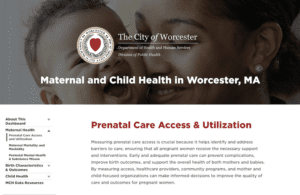Who is a member?
Our members are the local governments of Massachusetts and their elected and appointed leadership.

The city of Worcester has launched a new public dashboard that tracks data on numerous aspects of maternal and child health.
A new online dashboard created by the city of Worcester provides maternal and child health data as part of an effort to improve the health of residents, address disparities that worsen outcomes for mothers and children, and humanize the data that drives public health policy.
The dashboard, launched last month, focuses on three broad categories: maternal health, birth outcomes, and child health. It comes two years after a Massachusetts Department of Public Health report finding that rates of severe maternal morbidity nearly doubled in Massachusetts over the last decade. The state has since passed a law promoting access to midwife care and out-of-hospital birth options, the creation of a state dashboard, and a task force.
Worcester says its dashboard will help the city and its community partners work toward greater health care equity and justice, protect vulnerable populations, and ensure access to the services and support residents need to experience pregnancy and childbirth safely and raise healthy children.
“We look at maternal and child health as really some of the most powerful predictors of a community’s overall well-being,” said Worcester Public Health Director Tamara Lundi. “We think that when our mothers and our babies are thriving, our entire city is thriving. So we felt like the dashboard really shared more than just numbers. We look at it as a community compass, if you will.”
Lundi said the dashboard aligns with broader efforts to spotlight community health issues, including substance abuse disorders. She said Worcester is also working on dashboards tracking tobacco usage and cessation efforts, and public health nursing, covering everything from vaccination rates to screenings for health threats such as diabetes and colon cancer.
The city has been partnering with UMass Chan Medical School through the Worcester Integrated Health Data Exchange to promote information sharing. The exchange, which began last year, initially focused on opioid abuse, but has expanded to incorporate maternal and child health as a priority and will support the data being presented in the city’s dashboard.
“That’s going to definitely enhance and make our data collection and analysis much more rich, and help it be much more tailored and specific to our Worcester maternal-child health efforts,” Lundi said.
City officials said the dashboard will bring together different data sets that may be scattered throughout state, federal and other websites.
In particular, Worcester seeks to improve conditions for its most vulnerable and medically underserved communities. Research has shown that people of color, and particularly Black mothers, are much more likely to experience severe health- and life-threatening complications around pregnancy and birth. Outcomes are also affected by patients’ socioeconomic status, disabilities, and access to quality health care services, among other factors.
Offering comparisons to state and national data, the dashboard tracks a range of data from pregnancy through early childhood, including access to doctors, midwives and doulas; conditions including gestational diabetes and hypertension; Cesarean births; low birth weights; infant mortality; pediatrician access; and insurance coverage.
Wura Arowosegbe, Worcester’s maternal and child health manager, said the dashboard “really empowers us to ask the right questions and also to look at our processes and plans, and see how much we’re working toward the things that are most critical and most important when it comes to maternal and child health.”
Because of the partnership with UMass Chan, Lundi said, the city will be able to incorporate more local and granular information in the dashboard as time goes on. The city is also collaborating with diverse communities, and will include the “voices of moms and families that are living what it is that we’re talking about [and] really bringing those numbers to life.”